Prof. Kathryn Weathersby

Following the compromise reached at the Council of Foreign Ministers in May 1947, which was discussed in the last post, the Joint Commission resumed its work in Seoul. The Soviet and American delegations had not fundamentally changed their goals, however. The proceedings therefore had the air of political theater, designed to advance the larger goals of the two occupying powers.
As the meetings began, the Soviets proposed that the Commission invite only the thirty largest parties to participate in a consultative body and allow all other groups to submit written questionnaires stating their views. The Americans opposed this suggestion, insisting instead that the Commission hold discussions with all parties that had at least 1,000 members in at least two provinces. After these discussions were completed, the Joint Commission would choose the members of a representative body that would then create a provisional government.
By June 7 the Soviets and Americans had agreed that they would consult with all parties that signed a statement pledging support for the Joint Commission. They also agreed to the Soviet proposal to exclude Japanese collaborators from participation in the provisional government. A subcommittee of the Commission would study the applications, which were due by June 23, then invite eligible parties for consultation in Seoul and Pyongyang. In addition, any party or social group could submit a questionnaire that expressed their preferences on Korea’s future government. By July 5 the Joint Commission and the eligible Korean parties would begin to create a provisional government and to work out the principles, structure, and platform of the future permanent government.
We might well react to the Joint Commission’s work with indignation. By what authority were the Soviets and Americans making such decisions about Korea’s future government? Why didn’t they finish their occupation duties regarding Japanese troops and civilians and leave it to Koreans to create their new government? We have addressed that very reasonable question in earlier posts, but it is now time to update the situation as of mid-1947.
In March 1947 President Truman announced the “Truman Doctrine,” in response to Soviet pressure on Turkey and an assumption that Moscow was supporting the Communist side in the Greek civil war. To deter the Soviet Union from further expanding its influence in states along its border, the president told Congress that “it must be the policy of the United States to support free people who are resisting attempted subjugation by armed minorities or by outside pressures.”
This American support was to be economic and political, however, not military. With regard to Korea, Washington believed that the danger of the US supplying such aid to southern Korea had prompted the Soviets to make the recent compromises on the Joint Commission. The president therefore ordered a program of economic aid to Korea, thinking this would force Moscow to agree to unification on American terms.
Since containing Soviet expansion was a global effort, all threatened places must be successfully defended if American resolve were to be believed. Therefore, the Joint Chiefs of Staff argued that Korea was “the one country within which we alone have for almost two years carried on ideological warfare in direct contact with our opponents, so that to lose this battle would be gravely detrimental to United States prestige, and therefore security, throughout the world.”
In the next post, we will look at how these views in Washington shaped an aid program for the American zone in Korea, regardless of the results of the Joint Commission.
[Sources: This post relies on the existing literature on the early Cold War and on James I. Matray, The Reluctant Crusade: American Foreign Policy in Korea, 1941-1950 (University of Hawaii Press, 1985).]
scapegoat ...
Posted using Partiko Android
Downvoting a post can decrease pending rewards and make it less visible. Common reasons:
Submit